Does Overstock.com (NASDAQ:OSTK) Have A Healthy Balance Sheet?

The external fund manager backed by Berkshire Hathaway's Charlie Munger, Li Lu, makes no bones about it when he says 'The biggest investment risk is not the volatility of prices, but whether you will suffer a permanent loss of capital.' It's only natural to consider a company's balance sheet when you examine how risky it is, since debt is often involved when a business collapses. We can see that Overstock.com, Inc. (NASDAQ:OSTK) does use debt in its business. But the real question is whether this debt is making the company risky.
When Is Debt A Problem?
Debt assists a business until the business has trouble paying it off, either with new capital or with free cash flow. If things get really bad, the lenders can take control of the business. While that is not too common, we often do see indebted companies permanently diluting shareholders because lenders force them to raise capital at a distressed price. Having said that, the most common situation is where a company manages its debt reasonably well - and to its own advantage. The first thing to do when considering how much debt a business uses is to look at its cash and debt together.
See our latest analysis for Overstock.com
How Much Debt Does Overstock.com Carry?
The chart below, which you can click on for greater detail, shows that Overstock.com had US$3.11m in debt in June 2019; about the same as the year before. However, it does have US$121.3m in cash offsetting this, leading to net cash of US$118.2m.
A Look At Overstock.com's Liabilities
According to the last reported balance sheet, Overstock.com had liabilities of US$203.8m due within 12 months, and liabilities of US$46.3m due beyond 12 months. Offsetting these obligations, it had cash of US$121.3m as well as receivables valued at US$23.6m due within 12 months. So its liabilities outweigh the sum of its cash and (near-term) receivables by US$105.2m.
Given Overstock.com has a market capitalization of US$596.4m, it's hard to believe these liabilities pose much threat. However, we do think it is worth keeping an eye on its balance sheet strength, as it may change over time. Despite its noteworthy liabilities, Overstock.com boasts net cash, so it's fair to say it does not have a heavy debt load! When analysing debt levels, the balance sheet is the obvious place to start. But it is future earnings, more than anything, that will determine Overstock.com's ability to maintain a healthy balance sheet going forward. So if you're focused on the future you can check out this free report showing analyst profit forecasts.
In the last year Overstock.com actually shrunk its revenue by 9.6%, to US$1.6b. That's not what we would hope to see.
So How Risky Is Overstock.com?
By their very nature companies that are losing money are more risky than those with a long history of profitability. And we do note that Overstock.com had negative earnings before interest and tax (EBIT), over the last year. Indeed, in that time it burnt through US$161m of cash and made a loss of US$154m. Given it only has net cash of US$121m, the company may need to raise more capital if it doesn't reach break-even soon. Summing up, we're a little skeptical of this one, as it seems fairly risky in the absence of free cashflow. For riskier companies like Overstock.com I always like to keep an eye on whether insiders are buying or selling. So click here if you want to find out for yourself.
At the end of the day, it's often better to focus on companies that are free from net debt. You can access our special list of such companies (all with a track record of profit growth). It's free.
We aim to bring you long-term focused research analysis driven by fundamental data. Note that our analysis may not factor in the latest price-sensitive company announcements or qualitative material.
If you spot an error that warrants correction, please contact the editor at editorial-team@simplywallst.com. This article by Simply Wall St is general in nature. It does not constitute a recommendation to buy or sell any stock, and does not take account of your objectives, or your financial situation. Simply Wall St has no position in the stocks mentioned. Thank you for reading.

 Yahoo Finance
Yahoo Finance 
